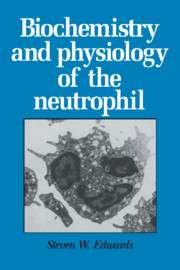Book contents
- Frontmatter
- Contents
- Abbreviations
- Preface
- 1 Neutrophils and host defence: The fight against infection
- 2 The development and structure of mature neutrophils
- 3 The generation and recognition of neutrophil-activating factors: Structure and function of neutrophil receptors
- 4 The cytoskeleton: The molecular framework regulating cell shape and the traffic of intracellular components
- 5 The respiratory burst: The generation of reactive oxygen metabolites and their role in microbial killing
- 6 Neutrophil activation: The production of intracellular signalling molecules
- 7 Neutrophil priming: Regulation of neutrophil function during inflammatory activation
- 8 Disorders of neutrophil function
- Index
8 - Disorders of neutrophil function
Published online by Cambridge University Press: 26 February 2010
- Frontmatter
- Contents
- Abbreviations
- Preface
- 1 Neutrophils and host defence: The fight against infection
- 2 The development and structure of mature neutrophils
- 3 The generation and recognition of neutrophil-activating factors: Structure and function of neutrophil receptors
- 4 The cytoskeleton: The molecular framework regulating cell shape and the traffic of intracellular components
- 5 The respiratory burst: The generation of reactive oxygen metabolites and their role in microbial killing
- 6 Neutrophil activation: The production of intracellular signalling molecules
- 7 Neutrophil priming: Regulation of neutrophil function during inflammatory activation
- 8 Disorders of neutrophil function
- Index
Summary
Introduction
The crucial role played by the neutrophil in protecting the host against bacterial and fungal infections is highlighted in patients with defects in neutrophil function. These individuals, either with low numbers of circulating neutrophils (i.e. neutropenias) or with specific defects in one or more key processes, are predisposed to life-threatening infections. Indeed, at neutrophil counts of < 1000/μl blood, individuals are at risk from infections, with the risk of infection inversely proportional to the neutrophil count. Neutropenias may be due to disease, such as congenital neutropenia, aplastic anaemias, agranulocytosis, acute myeloid leukaemia and the myelodysplastic syndromes. In such cases, CSFs (e.g. GM-CSF, G-CSF) have been used clinically to improve the circulating neutrophil count. Whilst initial results have shown some promise, such CSF therapy is not without its drawbacks. Some malignant cells may be stimulated by CSF therapy, and accumulation of neutrophils in the lungs may occur. Circulating levels of CSFs may also increase the expression of adhesion molecules on the surface of circulating cells, which may result in increased adhesion of neutrophils to endothelial cells or in increased neutrophil–neutrophil or –platelet interactions.
Neutropenias may also arise as a side effect or deliberate consequence of therapy. For example, some drugs used in the treatment of inflammatory disorders are immunosuppressive, and if these decrease the number of circulating neutrophils to below the critical threshold level, then susceptibility to infection may result. During chemotherapy for the treatment of solid tumours, an inevitable consequence of cytotoxic therapy is that the bone marrow will be destroyed by the drugs; thus, patients will have a considerable risk of infection during this induction period.
- Type
- Chapter
- Information
- Biochemistry and Physiology of the Neutrophil , pp. 263 - 290Publisher: Cambridge University PressPrint publication year: 1994



